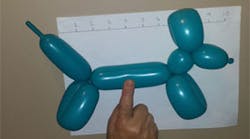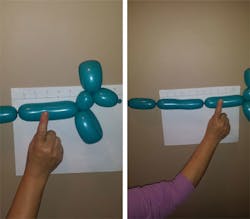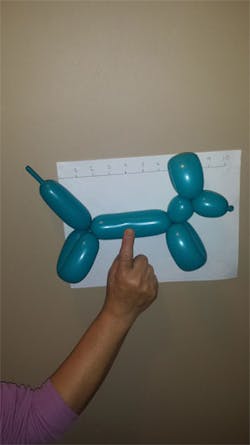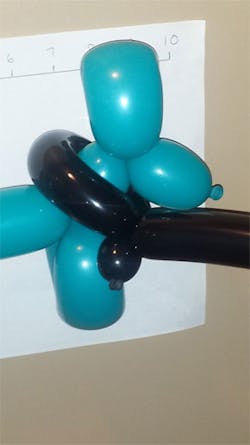Balloon sculptures in the dental practice? Not just a bunch of hot air
Balloon sculptures can be a powerful dental patient management tool. In this article, balloon sculptor Bruce Lawson explains how and provides instructions for making a three-twist balloon dog.
Welcome to Balloon Twisting 101! Balloon sculptures can be a powerful patient management tool.
Let me tell you how I got into them: About 20 years ago, my wife and I bought a balloon kit to have some fun with our children, Alexander and Deborah, who were about eight and four years old. It worked; we had a lot of fun. The kids outgrew it eventually, but I didn't. It was the mid '90s, just when the Internet was becoming a factor in people's daily lives. I hooked into the balloon community, and the rest is history.
My passion is entertaining with balloons. The power of your passion is what will sell your performance. Whatever your passion is, share it with a kid, and he or she will be engaged and more at ease. Your passion could be making kids smile, music, photography, or sports. It doesn't matter what it is—share it with children, and they will be enchanted. Many dental professionals use what Schwartz calls "The Magic of a Healthy Smile" as "a means for practice marketing, patient education, and the reduction of patient stress and fear." (1) There’s some science to this as well: Peretz, et al., found that providing a child with a magic trick before dental treatment improves patient cooperation. (2) Children who witnessed a magic trick were able to settle into the dental chair faster and were more cooperative when sitting for dental radiographs when compared to children who did not witness a magic trick.(2)
I might not be the greatest balloon twister in the world, but I am one of the most passionate. And today I am going to share a little of my passion with you. Balloon sculptures are a wonderful way to connect with your patients—and the connection is what matters here. When I make children (or adults) balloon sculptures, they take a little piece of me home with them. The value lies in the interaction between us, not in the complexity of the sculpture.
The basics
Let's cover a few basic rules. First, never inflate a balloon all the way. The length of the uninflated tail depends on how many twists you will be putting into the balloon. The instructions will usually tell you how long the uninflated tail should be. Second, always let a small puff of air out of the balloon before you tie it. This is called the "burp." The balloon will be a little softer, easier to work with, and less likely to pop. This is critical, especially when you make a hat. And third, if a balloon doesn't feel right, don't use it. The manufacturing process is not perfect. Sometimes a balloon is too thin. You'll be able to feel it while you're inflating it. If it blows up too easily or if it seems a little fatter than the other balloons, don't use it. It will pop.
The supplies
The balloon we'll be using is the 260: It measures 2 inches across and about 60 inches long when inflated to the max. Other common shapes you might use include the 160, the 350, the 5-inch round, and the 6-inch heart. For your first order, I would recommend a bag of 100 Qualatex "Traditional Assortment" 260s, plus a bag or two of any particular colors you like. I use a lot of white, black, and red balloons, but that's just my taste. You can't go wrong with a bag of 100 assorted pink, red, & white 6-inch hearts. Many little girls love them. As you progress, you might want to add some other shapes, sizes, or character balloons.
Do not buy balloons at a store. The balloons can be very thin and prone to popping. Also, avoid transparent colors—they're beautiful, but they are thin, and again, this makes them more likely to pop. Most professional twisters use the standard nontransparent Qualatex or Betallic brands. Clown Supplies in Laconia, New Hampshire, is the supplier I like. If you'd like, you can inflate balloons with your air-water syringe, so you don't have to purchase a pump unless you want to practice at home. If you do want to get a pump, I recommend the red Qualatex hand pump.
The three-twist balloon dog
Your first project is the three-twist balloon dog. Blow up your balloon and leave 4 or 5 inches uninflated. Don't forget to burp it before you tie it. If you are right-handed, hold the knot on the right side.
Starting at the knot end, twist a bubble approximately 2 inches long (figure 1). (Note: The 2 inches should include the tapered ends of the bubble.) Twist it around three times, but don't let go of it, or it will unwind. You have just made the snout.
Now twist a 5-inch bubble (figure 1). Make a loop and pinch it all together at the snout. Twist it around three times to make it secure. If it’s hard to handle, let it untwist and then give it a gentle squeeze. This will soften it up a bit. This is called the "lock twist." You have just made the ears and completed the head (figure 2). You will repeat this same pattern two more times to make the neck and front legs, and the torso and rear legs.
For the neck, twist a 1-inch bubble (figure 3). For the front legs, make a 6-inch loop (figure 4), and repeat the lock-twist technique you used to make the ears.
Planning to leave 6 inches for the rear legs and at least another inch for the tail, twist a 3- to 5-inch bubble for the torso (figure 5). Then make another set of legs with another 6-inch loop and lock twist. You should have a little left over for the tail (figure 6).
Voilà! You are now a balloon twister (figure 7)! If your dimensions are off, don't worry. Do it a few times and you will get it to look proportional.
There is always something you can add to have more impact. Remember how I said that the connection—the interaction between performer and audience—is what really matters? Here is how you can make the three-twist balloon dog, the simplest of balloon sculptures, into a memorable experience for a child: Ask “Would you like a leash?” The answer is almost always an enthusiastic "Yes!”
The leash is simple. I like to use a 160 for the leash, but the 260 also works. Fill the balloon, give it a good burp so it's very soft, and tie it. Make a 1-inch bubble at the knot end (figure 8).
Wrap it around the child's neck, as though you were going to tie it. He or she will squirm away. You can say, “But you said you wanted a leash!” The child will probably tell you the leash was for the dog. Turn to Mom: “Mrs. Smith, Isabel and I are at an impasse. I offered her a leash for her neck. Now she says she wants it around the dog's neck. You get to decide where it goes.” After some deep thought and wavering back and forth, Mom will agree to put it around the dog's neck. Wrap it around the dog's neck, and lock twist it in place (figure 9). Then, tell the child not to let the dog touch the floor while walking it, or it will pop. (That's not a joke—that's for real!)
Other resources
If you just search for "balloon animals" on Google or YouTube, you will find more balloon-sculpting resources than you will ever have time to look at. Many of them are very good, but here are some that I like:
• For more instruction on the three-twist balloon dog, try this video from the "Expert Village" series, which offers a lot of basic balloon instruction.
• The "Expert Village" series also offers instruction for making this balloon dog, which is slightly more complicated than the three-twist balloon dog.
• Professor Wonder's gallery is a good resource for other simple designs.
• Michael Floyd has a lot of good, simple stuff on his YouTube channel, as well.
Editor's Note: This article first appeared in Pearls for Your Practice: The Product Navigator.Click here to subscribe. Click here to submit a products article for consideration.
References
1. Schwartz S. It’s magic: a unique practice management strategy. J Contemp Dent Pract. 2003;4(4):121–126.
2. Peretz B, Gluck G. Magic trick: a behavioural strategy for the management of strong-willed children. Int J Pediatr Dent. 2005;15(6):429–36.
Bruce Lawson is the owner of Bruce’s Fun Company in the Boston area. He has been entertaining children for 20 years with balloons, bubbles, and origami. He has spoken on patient management at Tufts Dental School and at Three Rivers Dental Conference in Pittsburgh. He can be reached at [email protected] or (978) 210-7464. Bruce and his team are available to train your staff in patient management, speak at your dental meeting, or appear at your practice.







